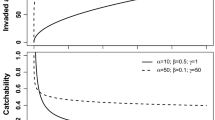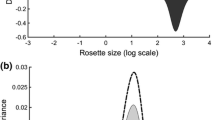Abstract
The major tools used to make population viability analyses (PVA) quantitative are stochastic models of population dynamics. Since a specially tailored model cannot be developed for every threatened population, generic models have been designed which can be parameterised and analysed by non-modellers. These generic models compromise on detail so that they can be used for a wide range of species. However, generic models have been criticised because they can be employed without the user being fully aware of the concepts, methods, potentials, and limitations of PVA. Here, we present the conception of a new generic software package for metapopulation viability analysis, META-X. This conception is based on three elements, which take into account the criticism of earlier generic PVA models: (1) comparative simulation experiments; (2) an occupancy-type model structure which ignores details of local population dynamics (these details are integrated in external submodels); and (3) a unifying currency to quantify persistence and viability, the ‘intrinsic mean time to extinction’. The rationale behind these three elements is explained and demonstrated by exemplary applications of META-X in the three fields for which META-X has been designed: teaching, risk assessment in the field, and planning. The conception of META-X is based on the notion that PVA is a tool to deal with rather than to overcome uncertainty. The purpose of PVA is to produce relative, not absolute, assessments of extinction risk which support, but do not supplant, management decisions.
Similar content being viewed by others
References
Akçakaya H.R. 1995. RAMAS GIS: Linking Landscape Data with Population Viability Analysis, Version 3.0. Applied Biomathematics, Setauket, New York.
Akçakaya H.R. 1997. RAMAS (R) Metapop: Viability Analysis for Stage-structured Metapopulations, Version 2. Applied Biomathematics, Setauket, New York.
Beissinger S.R. and Westphal M.I. 1998. On the use of demographic models of population viability in endangered species management. Journal of Wildlife Management 62: 821-841.
Boyce M.S. 1992. Population viability analysis. Annual Review of Ecology and Systematics 23: 481-506.
Brook B.W., Burgman M.A. and Frankham R. 2000a. Differences and congruencies between PVA packages: the importance of sex ratio for predictions of extinction risk. Conservation Ecology 4: 6. http://www.consecol.org/vol4/iss1/art6.
Brook B.W., O'Grady J.J., Chapman A.P., Burgman M.A., Akçakaya H.R. and Frankham R. 2000b. Predictive accuracy of population viability analysis in conservation biology. Nature 404: 385-387.
Burgman M. and Possingham H. 2000. Population viability analysis for conservation: the good, the bad and the undescribed. In: Young A.G. and Clarke G.M. (eds), Genetics, Demography and Viability of Fragmented Populations. Cambridge University Press, Cambridge, UK, pp. 97-112.
Burgman M.A., Ferson S. and Akçakaya H.R. 1993. Risk Assessment in Conservation Biology. Chapman & Hall, London.
Drechsler M. and Wissel C. 1997. Separability of local and regional dynamics in metapopulations. Theoretical Population Biology 51: 9-21.
Drechsler M. and Wissel C. 1998. Trade-offs between local and regional scale management of metapopulations. Biological Conservation 83: 31-41.
Frank K. 2004. Ecologically differentiated rules of thumb for habitat network design-lessons from a formula. Biodiversity and Conservation 13: 189-206 (this issue).
Frank K. and Wissel C. 1998. Spatial aspects of metapopulation survival: from model results to rules of thumb for landscape management. Landscape Ecology 13: 363-379.
Frank K., Lorek H., Koester F., Sonnenschein M., Wissel C. and Grimm V. 2003. META-X: Software for Metapopulation Viability Analysis. Springer, Berlin.
Grimm V. 1999. Ten years of individual-based modelling in ecology: what have we learned, and what could we learn in the future? Ecological Modelling 115: 129-148.
Grimm V. 2002. Visual debugging: a way of analyzing, understanding, and communicating bottom-up simulation models in ecology. Natural Resource Modeling 15: 23-38.
Grimm V. and Storch I. 2000. Minimum viable population size of capercaillie Tetrao urogallus: results from a stochastic model. Wildlife Biology 5: 219-225.
Groom M.J. and Pascual M.A. 1998. The analysis of population persistence: an outlook on the practice of viability analysis. In: Fiedler P.L. and Kareiva P.M. (eds), Conservation Biology: For the Coming Decade. Chapman & Hall, New York, pp. 4-26.
Hanski I. 1994. A practical model of metapopulation dynamics. Journal of Animal Ecology 63: 151-162.
Hanski I. 1999. Metapopulation Ecology. Oxford University Press, Oxford, UK.
Hanski I., Alho J. and Moilanen A. 2000. Estimating the parameters of migration and survival for individuals in metapopulations. Ecology 81: 239-251.
Henle K., Amler K., Bahl A., Finke E., Frank K., Settele J. et al. 1999. Faustregeln als Entscheidungshilfen für Planung und Management im Naturschutz. In: Amler K., Bahl A., Henle K., Kaule G., Poschlod P. and Settele J. (eds), Populationsbiologie in der Naturschutzpraxis. Isolation, Flächenbedarf und Biotopansprüche von Pflanzen und Tieren. Ulmer, Stuttgart, Germany, pp. 267-290.
Kindvall O. 2000. Comparative precision of three spatially realistic simulation models of metapopulation dynamics. Ecological Bulletins 48: 101-110.
Koivisto I. 1963. Ñber den Ortswechsel der Geschlechter beim Auerhuhn (Tetrao urogallus) nach Markierungsergebnissen. Die Vogelwarte 22: 75-79.
Köster F., Stephan T., Finke J. and Sonnenschein M. 2000. Ein Simulationswerkzeug zum praktischen Einsatz in Naturschutz und Landschaftsplanung-ExiDlg. In: Möller D.P.F. (ed), Frontiers in Simulation, Simulationstechnik, Vol. 14. Symposium in Hamburg, September 2000. ASIM (Arbeitsgemeinschaft Simulation), Germany, pp. 503-508.
Lacy R.C. 2000. Structure of the VORTEX simulation model for population viability analysis. Ecological Bulletins 48: 191-203.
Lacy R.C., Hughes K.A. and Miller P.S. 1995. VORTEX: A Stochastic Simulation of the Extinction Process, Version 7, User's Manual. IUCN/SSC Conservation Breeding Specialist Group, Apple Valley, Minnesota.
Lindenmayer D.B., Burgman M.A., Akçakaya H.R., Lacy R.C. and Possingham H.P. 1995. A review of the generic computer programs ALEX, RAMAS/space and VORTEX for modelling the viability of wildlife metapopulations. Ecological Modelling 82: 161-174.
Ludwig D. 1996. The distribution of population survival times. American Naturalist 147: 506-526.
Marshall K. and Edwards-Jones G. 1998. Reintroducing capercaillie (Tetrao urogallus) into southern Scotland: identification of minimum viable populations at potential release sites. Biodiversity and Conservation 7: 275-296.
Moilanen A. 1999. Patch occupancy models of metapopulation dynamics: efficient parameter estimation using implicit statistical inference. Ecology 80: 1031-1043.
Moilanen A. 2000. The equilibrium assumption in estimating the parameters of metapopulation models. Journal of Animal Ecology 69: 143-153.
Moilanen A. 2002. Implications of empirical data quality for metapopulation model parameter estimation and application. Oikos 96: 516-530.
Moilanen A. and Nieminen M. 2002. Simple connectivity measures in spatial ecology. Ecology 83: 1131-1145.
Moilanen A., Smith A.T. and Hanski I. 1998. Long-term dynamics in a metapopulation of the American pika. American Naturalist 152: 530-542.
Possingham H.P. and Davies I. 1995. ALEX: a model for the viability analysis of spatially structured populations. Biological Conservation 73: 143-150.
Shaffer M.L. 1981. Minimum population sizes for species conservation. BioScience 31: 131-134.
Sjögren-Gulve P. and Hanski I. 2000. Metapopulation viability analysis using occupancy models. Ecological Bulletins 48: 53-71.
Soulé M.E. (ed). 1986. Conservation Biology. Sinauer, Sunderland, Massachusetts.
Stelter C., Reich M., Grimm V. and Wissel C. 1997. Modelling persistence in dynamic landscapes: lesson from a metapopulation of the grasshopper Bryodema tuberculata. Journal of Animal Ecology 66: 508-518.
Stephan T. 1993. Stochastische Modelle zur Extinktion von Populationen. Ph.D. Thesis, Philipps-University Marburg, Germany.
Storch I. 1993. Habitat use and spacing of capercaillie in relation to forest fragmentation patterns. Dissertation, University of Munich, Germany, 97 pp.
Storch I. 2001. Capercaillie. BWP update. The Journal of Birds of theWestern Palearctic 3(1): 1-24.
Storch I. and Segelbacher G. 2000. Genetic correlates of spatial population structure in central European capercaillie and back grouse: a project in progress.Wildlife Biology 6: 239-243.
Ter Braak C.J.F., Hanski I. and Verboom J. 1998. The incidence function approach to modelling of metapopulation dynamics. In: Bascompte J. and Solé R. (eds), Modeling Spatiotemporal Dynamics in Ecology. Springer, Berlin, Germany, pp. 167-188.
Verboom J., Lankester K. and Metz J.A.J. 1991. Linking local and regional dynamics in stochastic metapopulation models. Biological Journal of the Linnean Society 42: 39-55.
Verboom J., Metz J.A.J. and Meelis E. 1993. Metapopulation models for impact assessment of fragmentation. In: Vos C.S. and Opdam P. (eds), Landscape Ecology of a Stressed Environment. Chapman & Hall, London, pp. 172-191.
Vos C.C., Verboom J., Opdam P.F.M. and Ter Braak C.J.F. 2001. Toward ecologically scaled landscape indices. American Naturalist 183: 24-41.
Wissel C. and Stöcker S. 1991. Extinction of populations by random influences. Theoretical Population Biology 39: 315-328.
Wissel C., Stephan T. and Zaschke S.-H. 1994. Modelling extinction and survival of small populations. In: Remmert H. (ed), Minimum Animal Populations. Springer, Berlin, Germany, pp. 67-103.
Author information
Authors and Affiliations
Corresponding author
Rights and permissions
About this article
Cite this article
Grimm, V., Lorek, H., Finke, J. et al. META-X: Generic Software for Metapopulation Viability Analysis. Biodiversity and Conservation 13, 165–188 (2004). https://doi.org/10.1023/B:BIOC.0000004317.42949.f7
Issue Date:
DOI: https://doi.org/10.1023/B:BIOC.0000004317.42949.f7




